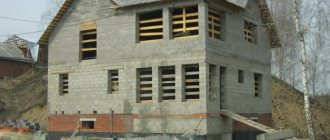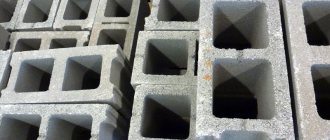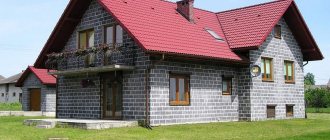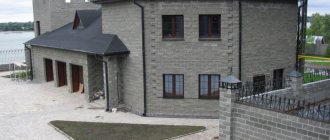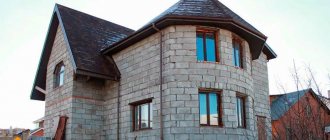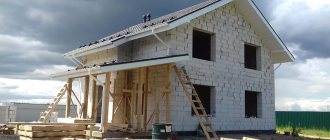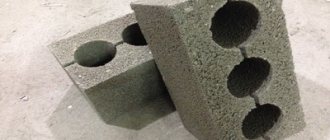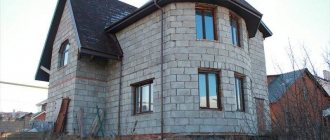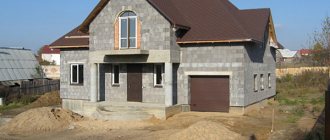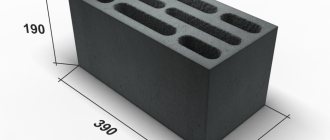Cinder blocks are very popular in low-rise and suburban construction. This wall stone is very convenient to lay, it is practically the cheapest building material. Cinder blocks are used in the installation of many building structures, even the foundation is no exception. Wall blocks are made from a special concrete mixture with various fillers. The low price of cinder blocks is explained by the fact that waste materials are used in their production. In order to better navigate a large assortment of wall blocks, you need to know the properties, pros and cons, as well as the feasibility of use in construction.
How to calculate the amount of cinder block?
After this, the cube is converted to the selected value and divided by the resulting volume of material.
1 m3 = 1000000 cm3 or 1000000000 mm3, then let’s look at a specific example. A cinder block for load-bearing walls of a standard size has the following parameters: 390 millimeters for length, 190 millimeters for width and height. First, let's determine the volume of one block 390 × 190 × 190 = 14079000 mm3. Now let’s see how many such products we get in one cube: 1000000000/14079000 = 71 pieces, and the result will be the same regardless of the units of measurement taken.
Next, we determine the number of partition blocks per cubic volume. It should be noted that such products have a standard size of 39 centimeters in length, 12 cm in width and 19 cm in height. Let's try to calculate differently, taking the value of cinder blocks in centimeters. As in the previous example, we calculate the volume of one product 12 × 19 × 39 = 8892 cubic meters. centimeter Now let’s find out how many of these cinder blocks will fit in one cube with a volume of 1000000/8892 = 112 pieces.
When purchasing any wall materials, you need to take 5-10 percent more. This is due to the possible destruction of the blocks during transportation, as well as loading or unloading. It should be noted that in cinder concrete masonry, a certain volume of the wall will be spent on installing mortar joints, therefore, in one cube of the assembled wall there are slightly fewer blocks than the calculated one, although this number can not be taken into account.
Start of construction
Before you begin the construction process, you need to decide on the size of your budget. There should be enough money to purchase ready-made material or for components for its subsequent manufacture. In addition, the construction process will also require funds from you, as will the repair process.
So, if you purchase everything you need to build a foundation and build walls on it, but there are not enough funds to continue construction, then all the work will go down the drain.
After all, we already wrote earlier that a cinder block absorbs moisture, which means that it will quickly become unusable, and everything will eventually have to be redone. If you cannot make all the calculations yourself, then contact a construction company that specializes in planned developments and calculates the amount of required material with an estimate.
You must also put in order all the documentation proving your right to property and so on.
History of the material
Residential and public buildings, factory workshops, fences and enclosures were erected from cinder blocks. Many of these buildings have survived to this day in very satisfactory condition. Previously, cinder blocks were made from concrete, where ash was used as a filler. It could be blast furnace slag - waste from the metallurgical industry, or coal residues formed after its combustion during the operation of boiler houses, power plants, combined heat and power plants (CHP).
The use of waste to make building stone also solved the problem of their disposal. Today, despite the name, the content of ash in a concrete solution is not considered mandatory. Consists of granite crushed stone, expanded clay, broken glass, broken brick and cement mortar.
Solution consumption and “cold bridges”
For laying cinder blocks, a simple cement mortar , which makes the masonry joints quite large - within 8-12 mm . Such seams are “cold bridges” and in winter the house will be quite cold. Aerated concrete blocks can be placed on a special glue , thanks to which the seam will be much smaller - only 2-3 mm .
In addition, the consumption of glue is significantly less than the consumption of cement mortar, which allows you to save on this cost item.
Cinder block weight, characteristics and dimensions, prices
The quality of one cinder block is checked by the weight of one cinder block. This means that the greater the mass, the thicker the walls and the better the solution is mixed during production during the vibration process. The degree of hardening also plays a role. The block should stand for about three weeks; it cannot be used before. Experienced builders determine quality in this way: the stone is weighed; if the indicator has significant deviations from the standard, it is thrown from a height of a meter. A small piece may break off from a properly made block. In the case when it falls apart, it is judged to be friable, which indicates a discrepancy between the parameters.
- Types of cinder blocks
- Specifications
- Prices
Main views and parameters
The size standard for cinder blocks depends on the fillers. In addition to blast furnace or granite slag, sand, pebbles, gravel, screenings of crushed stone, expanded clay, and sawdust are used. Volcanic grains – perlite – are also suitable as a plasticizer. The characteristics of each raw material affect the technical characteristics of the cinder block.
1. Solid stone is suitable for arranging a plinth, foundation, and load-bearing structures. Strength is provided by crushed stone, sand and pebbles added to the concrete base before processing on a vibrating machine. Depending on the amount of raw materials, the grade is determined - M100 and M125. The weight of a solid cinder block 390x190x190 is 25-28 kg. It copes well with heavy loads, but is unable to retain heat in the room.
2. For the construction of walls and interior partitions, use a cinder block with two or three channels, the percentage of which does not change. The void ratio plays a role here, from 28 to 40%. Blocks with rectangular internal cavities are easy to cut, which is convenient for installation. Depending on whether expanded clay or sand acts as an additive mixture, the following brands are released for sale: M75 and M50. The weight of a hollow cinder block ranges from 18-23 kg. There are two sizes: 390x120x188 and 390x90x188. Some blocks are made using special molds to produce a decorative textured surface.
A stone with a coefficient of 40% has the highest thermal conductivity and low strength. It is used in conjunction with other categories to protect against the cold. The semi-block weighs 10-15 kg, brand – M35. It has two wide channels intended for plasticizers, which are lightweight mixtures of sand, sawdust, and combustion waste.
When calculating the required quantity, parameters are taken into account, since the weight depends on its voidness. Preparation of concrete involves the inclusion of plasticizing substances in the solution, ensuring frost resistance and water resistance. After vibrocompression, blocks are formed, which are laid to dry for at least 10 hours.
Deviations in the geometry of the blocks are allowed with an error of plus or minus 3 mm. In case of greater disturbance, the masonry will be uneven, with seams of different thicknesses. This will lead to difficulties in construction and unnecessary consumption of mortar. Compliance with production technology ensures simple operation and short construction times. Hand-made production is possible, but the quality standard of the block and the size of the block is achieved subject to the use of special equipment and a multi-cell shape.
Properties and characteristics
In addition to conventional building materials, blocks are produced in a color palette and with imitation of rock stone or brick. For this purpose, polyurethane forms are used, which allow the side surface to be textured, which eliminates the need for additional finishing, especially for facades and plinths. Hollow cinder block 400x200x200 is suitable for decorating sidewalks and pavements.
Construction Features
The technology for constructing buildings from cinder block material is practically no different from building, for example, from brick. In the same way, the foundation is made, the walls are erected, the roof is installed and communications are laid. Differences are only noticeable at certain stages.
- Protecting the foundation from water. Due to the fact that this type of building material is hygroscopic, it simply needs to be protected from moisture, which will come from everywhere, including the foundation. Therefore, foundation waterproofing work must be carried out with special care.
- Masonry.
A cinder block is laid in almost the same way as a brick. The method of ligating the blocks is the same and has not changed for many years. The difference lies in the fact that the cinder block has voids. They are used depending on what purpose is being pursued. If the house is low, then the voids are simply filled with cement. This allows for additional strengthening of the structure. If the building has several floors, then a frame made of reinforcement is inserted into the cavity. This allows the material to withstand the load coming from the upper floors. - A cinder block house cannot do without an armored belt. Of course, I use it in the construction of all buildings made of blocks. It is designed to distribute the load that comes from the floor slabs onto all walls. If the house is being built from cinder block, then the armored belt is especially important. They even make it a little larger than usual.
Pros and cons of the material
The appearance of cinder blocks is directly related to man’s natural desire for waste-free production. In the USSR in the post-war years, production developed at a rapid pace. Metallurgical plants were literally overgrown with mountains of slag. Then the decision came to use this waste to create building materials.
The slag served as a filler for the cement-sand mixture. The resulting mass was molded into large “bricks”. The finished blocks were too heavy - they weighed 25-28 kg. To reduce weight, voids were made in them. Hollow specimens turned out to be a little lighter - from 18 to 23 kg with standard dimensions.
The name cinder blocks is still used today, although not only slag, but also other components are used as fillers. In modern blocks you can find granite screenings or crushed stone, river gravel, broken glass or expanded clay, and volcanic mass. The production of cinder blocks is most often carried out by small businesses. Small private enterprises produce building blocks on vibrating machines, filling several molds with cement mixture at once. After molding and compacting, the “bricks” gain strength for at least a month.
Cinder blocks have certain advantages and disadvantages.
- The advantage of block building material, first of all, is its low cost. That is why the material is in wide demand.
- This building material also has other positive characteristics. For example, blocks do not change their size after laying out. The structure will not shrink, which means that design calculations will not be adjusted during the construction process.
- The strength and hardness of the “big brick” determine its service life. This is neither more nor less – a whole 100 years! Durability is not calculated, but time-tested. There are many buildings from the middle of the last century that “stand firmly on their feet.” The houses are not lopsided or falling apart, only the facades require cosmetic repairs.
- The blocks react poorly to ultraviolet radiation and temperature changes. The material is not edible for rodents and insects.
- Thanks to the increased size, construction is proceeding at a rapid pace. Much less masonry mixture is used for laying blocks than, for example, for a brick wall of similar sizes.
- No street noise can be heard behind a cinder block wall, because it is capable of absorbing sounds.
- Finally, if you have simple equipment and desire, blocks can be made at home, which will further reduce the cost of construction.
The building material has as many disadvantages as advantages.
These include the following characteristics.
- Unprepossessing appearance.
- It is problematic to attach to walls due to voids in the body of the block.
- The need for cladding to make the building attractive and protect the building material from external moisture.
- Fragility. If it falls during work, during transportation or loading, the unit may break.
- High thermal conductivity. Without additional insulation, the building does not retain heat well.
- Wide tolerance limits. Dimensions may differ significantly from nominal.
Useful tips
It is recommended to check compliance with the horizontal level more often. This will prevent the walls from warping. If subsequent wall finishing is not carried out, care must be taken to ensure the aesthetics of the seams between the blocks. They can be decorated with a simple rounded stick, allowing for slight pressing of the seams. This must be done until the solution has completely hardened.
When marking cinder blocks, use colored crayons. They are more noticeable on blocks, as opposed to simple pencils.
Do not prepare too much solution. Make as much as you can use at once. Otherwise, it will harden and will not be suitable for further masonry.
Cinder block is quite vulnerable to moisture, so it is highly recommended to plaster it after laying. At the same time, use a reinforcing mesh to prevent the plaster from falling off the walls in the future.
Weight of one cinder block
The mass of a cinder block directly depends on its actual volume: the stone can be solid or hollow. There are three categories of slag wall stones on the market, so let’s put each group into a separate weight category:
- Full-bodied. The absence of voids increases the strength of the cinder block, but makes it much heavier. Such stones can be used for load-bearing walls and foundations; their weight varies between 25-29 kg.
- Hollow. Such stone is usually used only for the construction of walls, including load-bearing structures. The weight of one piece is 12-23 kg.
- Semi-block. In such stone, voids predominate, so the material is used only for interior partitions. Cinder block weight: 9-13 kg.
According to GOST 6433-99 “Concrete wall stones”, the density of hollow cinder blocks should not exceed 1650 kg/cub.m., and solid cinder blocks – no more than 2200 kg/cub.m.
Naturally, in addition to the % voidness and density, the weight of the stone is also affected by the dimensions, so a large cinder block 200 200 400 will have the greatest weight.
| Size | Block composition | Emptiness, % | Weight | Note |
| 390x190x188 | Sand-cement | 40 | 10 | Open bottom |
| 390x190x188 | Sand-cement | 40 | 12 | With closed bottom |
| 390x190x188 | Expanded clay concrete | 40 | 10 | With closed bottom |
| 390x190x188 | Sand-cement | 30 | 14,5 | With closed bottom |
| 390x190x188 | Sand-cement | 28 | 16 | With closed bottom |
| 390x90x188 | Sand-cement | 30 | 10 | Double-hollow |
| 390x90x188 | Expanded clay concrete | 30 | 9 | Double-hollow |
| 390x190x188 | Sand-cement | — | 28 | Full-bodied |
| 390x190x188 | Expanded clay concrete | — | 25 | Full-bodied |
| 400x200x200 | Sand-cement | — | 29 | Full-bodied |
| 400x200x200 | Expanded clay concrete | — | 26 | Full-bodied |
Cinder blocks pros and cons.
The advantages of blocks include:
- durability and strength;
- resistance against fungi and rodents;
- fire resistance;
- fairly low thermal conductivity (especially hollow ones);
- light weight and increased dimensions, allowing for quick construction;
- variety of block shapes and voids in them;
- ease of manufacture allows for off-site production.
Along with the advantages, the blocks also have the following disadvantages:
- low level of noise absorption;
- high level of water absorption;
- high thermal conductivity (solid products);
- It is difficult to communicate through them.
These disadvantages explain their frequent use for the construction of ancillary buildings (garages, summer kitchens, etc.), as well as as an inexpensive facing material, curb stones and paving slabs.
What deviations are allowed in the production of cinder blocks
Blocks that have the following defects cannot be sold:
- deviations in length and width are more than 3, and heights are more than 4 mm;
- the curvilinearity of horizontal edges is more than 3 mm, and of vertical edges – 2 mm;
- shell depth exceeds 4 mm;
- nodules and depressions more than 2 mm;
- chips on edges more than 5 mm deep and length more than 50 mm.
Making cinder blocks yourself
Handy amateur builders make do with cinder blocks made on their own directly at the construction site. To do this, they need a form and materials (water, cement and fillers). Construction waste (shards of brick, glass, etc.) is often used as the latter. This method of construction allows you to save significant money.
Cinder block house: what you need to consider
- If a cinder block is involved in the construction of a house, you cannot do without a high and strong strip foundation.
- The base also needs to be made high: in the future this will protect the lower part of the house from getting wet.
- The cinder block wall is very dense, which means that unexpected difficulties may arise during the installation of pipes and electrical wiring. Often, builders use special equipment to lay pipes. In any case, this issue is considered in advance, even before the house is built.
Most often, cinder blocks are used in the construction of cottages and outbuildings. With the help of this wall stone, large channels and air ventilation chambers are erected in houses. Cinder blocks can also be seen as paving slabs and curb stones.
Cinder block size: standard and required quantity for construction
Knowing the height of the cinder block, as well as other standard parameters of the material, you can easily convert these values into m³. It is much more convenient to use this unit of measurement, since the amount of cinder block required for construction is usually calculated in m³.
To calculate the required number of blocks, there are special formulas and calculators
When starting construction work, it is extremely important to correctly and accurately determine the required amount of material. Since the standard parameters of cinder blocks differ from the sizes of conventional bricks, the calculations take place according to a completely different scheme
First of all, you need to know how many cinder blocks are in the cube. In order to calculate the volume of each unit, you should multiply the width, height and length of the building material in cm. Next, 1 million cm³ must be divided by the resulting number. As a result, it will be possible to determine how many cinder blocks are in one cube. There are usually 72 standard cinder blocks in one m³.
Many people believe that one pallet of cinder concrete blocks is equal to 1 m³. This is a misconception that often leads to errors during calculations. A standard pallet holds 60 stones, which is slightly less than 1 m³.
Knowing the exact dimensions of the cinder block, it is easy to calculate the required quantity
Calculation of the amount of material, sizes of cinder blocks and prices
During construction, it is important to know how many blocks are needed for 1 m². Wall thickness plays an important role in these calculations.
For example, to build 1 m² of wall, the thickness of which is equal to half the whole block, you will need 13.6 pieces. If the wall is formed into a whole block, the amount of material should be doubled, that is, 27.2 stones will be needed. It must be taken into account that in practice fewer blocks are required, since the thickness of the mortar joint is not taken into account during calculations.
As for cost, the most expensive are the base and foundation blocks M100-125. Wall and partition stones M50-75 are a little cheaper. Thermal insulation products are inexpensive, but their strength is low - M35.
Table of sizes and prices for cinder blocks of different types and brands:
| View | Size, cm | Brand | price, rub. per piece |
| Full-bodied | 40x20x20 | M50 M75 M100 | 27 30 34 |
| Solid with expanded clay | 39x19x19 39x9x19 | M75 M50 | 43 27 |
| Double-hollow | 38.8x19x18.8 | M75 | 35 |
| Three-hollow | 39x19x18.8 | M50 | 31 |
| Quadruple-hollow | 39x19x18.8 | M75 | 28 |
| Septal hollow | 39x12x19 39x9x18.8 | M75 M50 | 26 17 |
| Decorative | 39x19x18.8 | M75 | 65 |
It should be noted that the price is approximate, since how much one cinder block costs is influenced by many factors, including the manufacturer, and the cost of an expanded clay concrete block is twice as high as the price of a cinder block.
Features and advantages of cinder block houses
The advantages of a cinder block house are obvious. The building will last a long time and be passed on from generation to generation. In terms of strength, it is difficult to compete with traditional materials. Its advantage is as follows:
- cinder block provides good insulation;
- buildings made of blocks will last more than a century;
- it has reliable thermal insulation;
- the building is able to withstand any impact of climatic anomalies;
- he is not afraid of fires;
- the construction process does not require special knowledge;
- It is quite possible to determine the thickness of the walls without resorting to outside help; a number of blocks are used for this. In this way you can calculate how many cinder blocks you need per house.
- the price is available for any financial opportunity;
- repair or reconstruction of the structure will not encounter any obstacles.
How to make the right choice
What should you pay attention to when purchasing piece cinder block stone? You need to use the services of certified manufacturers. This approach can most fully guarantee the high quality of building materials.
It is also necessary to inquire about the exact composition of the original ingredients and the environmental certificate of suitability for use in residential construction.
It is advisable to familiarize yourself with laboratory test reports and find out strength characteristics such as frost resistance, weather resistance, and water resistance.
An external inspection is required. The product must have the shape of a regular parallelepiped. The dimensions of the edges should not differ by more than 1...2 mm, both on one stone and on any other randomly selected from the proposed batch. Concrete on external surfaces must be smooth, without signs of looseness or imperfection. The voids must be symmetrical and in no case connected to external planes in the form of cavities.
Causes of cracks
The conditions for cracks to appear in cinder block walls are quite sufficient. First of all, they arise during the movement of the soil and the foundation of the house , a sudden jump in temperature, high humidity, and violations made during production technology and when laying blocks.
How can I seal the cracks?
If the house is being built in an area with a high level of groundwater, then drainage will be required to drain it. If, in addition, the soils are characterized by special mobility, then it is better to build the foundation on piles. Reinforcement of walls using a mesh: metal, basalt or fiber-optic thread helps prevent small cracks.
But what to do if such a problem appears? In the case where the block on the external masonry is cracked, it will need to be restored.
Basic measures for the restoration of cracks:
- Carefully clean the damage by removing dust from the surface with water and a brush.
- They fill the gap with steel T-shaped anchors, fixing them with dowels on both sides.
- Seal the gap with a solution of cement and sand, and with ground particles of the block.
Advantages and disadvantages of cinder block
The advantages of this wall material include:
- Relatively low price of the product.
- Due to the large size of one block, construction time is significantly reduced, which means the cost of work is reduced.
- The masonry technique is simple; you can do it yourself.
- A variety of filler compositions for concrete mixtures. You can always choose a material that suits its characteristics specifically for you.
- Long service life. Standard service life is 100 years.
- By using decorative cinder block, you do not need to spend money on plastering or cladding the building.
- High sound insulation. Like any concrete, cinder block absorbs sound.
Disadvantages of cinder blocks:
- Heavy weight of some types of products.
- Unsightly appearance. If you can’t buy decorative cinder blocks in your area, then it’s difficult to find a craftsman who can beautifully lay out this wall stone.
- After the Chernobyl accident, people began to treat this product with caution. There were, and still are, many rumors that the results of its testing for radioactivity can be unpredictable, and that the presence of a bouquet of elements of the periodic system in blast furnace slag can be potentially hazardous to health.
But whoever is forewarned is forearmed. And this very significant (maybe hypothetically) disadvantage can always be balanced by advantage No. 4.
The main thing is to approach the choice of manufacturer responsibly. Find out what equipment he uses, how production technology is followed, what filler he uses, and where it comes from.
Construction stages
As with building a brick house, all corners must be carefully aligned. The end result should be a perfect rectangle shape. Then four cinder blocks are placed on the surface of the foundation. They are leveled with a building level and a stretched cord. After this, a layer of cement mortar is applied to the surface. It is on this that the first row of cinder blocks is placed. If necessary, add viscosity to the solution, add ordinary ash to it. If you have red clay, then it will do the same.
The blocks are laid down very simply. There are very few differences from brickwork. The solution is applied with a trowel. The stone is placed at an angle to the surface, turned so that it is parallel to the surface of the wall, and pressed tightly against the stone that was laid earlier. In this case, you need to lightly tap the concrete block with a hammer. Excess mortar residues are removed with a paint trowel.
The very first rows must be laid out as accurately as possible. When erecting them, you need to use a building level and a plumb line to check how smooth the surface is. The more often you carry out this check, the faster the work will go. In addition, you will not have to correct any mistakes made.
Cons of cinder blocks
But, despite so many advantages, cinder blocks also have their own disadvantages, which you should also be aware of when choosing this material for the construction of buildings. The main disadvantages of cinder blocks include:
- the characteristics of blocks in one batch can vary significantly when manufactured at home;
- if the filler material of the blocks is subject to destruction (for example, sawdust), then the actual service life of walls made of such material may be lower than the calculated one;
- when purchasing industrially produced cinder blocks, you can purchase a material that is not environmentally friendly - production waste can emit harmful substances;
- cinder blocks are quite difficult to plaster due to poor adhesion of the plaster to the block material;
- blocks are susceptible to destruction under the influence of freezing moisture penetrating into the pores of artificial stones (when constructing walls made of cinder blocks, it is recommended to install eaves overhangs of sufficient length with gutters for draining rainwater and a reliable blind area around the perimeter of the walls).
As you can see, there are also disadvantages. But for the construction of a bathhouse, garage or small utility rooms they are not decisive, and cinder blocks are quite suitable for the construction of their walls. Therefore, you should not be afraid to choose this material if a comparison of the cost of construction shows that construction from cinder blocks will cost less than brick walls or the construction of a log house.
Creating a foundation
When the documentation is in order and all materials have been purchased, you can begin digging a pit for the foundation. To build the latter, you will need cement, reinforced concrete foundation blocks, crushed stone, gravel and sand. If you are planning to create a basement or want to build a garage under the house, then the pit should be larger and deeper than usual.
The foundation itself, as a rule, has a strip structure. Especially if we are talking about a low-rise building. The quality of the soil on which the house is built also influences how the foundation will look. Its height should be at least 70 centimeters above ground level. This will protect the blocks from possible getting wet.
When the foundation is ready, it must stand for at least one month.
But laying the plinth is an exception. Its layer must be at least five rows if the building is built from concrete blocks. The lower part of the base must be completely isolated from the surface of the foundation itself. The upper part of the base is covered with a layer of waterproofing.
How many cinder blocks in a cube
With these dimensions, 3×5 = 15 blocks will fit in one row on a pallet.
It is known that the weight of a hollow cinder block is 13 kilograms, and a solid one is 20 kilograms. From this value it can be determined that the mass of one row of products will be 15 × 13 = 195 kg. Taking this value into account, you can find out that the maximum number of rows on a pallet will be no more than five 1000/195 = 5, so in one pallet there will be 5 × 15 = 75 pieces of such cinder blocks.
Now let's deal with solid blocks. As we have already said, the mass of such a product corresponds to 20 kilograms, so one row will weigh 15 × 20 = 300 kilograms. This means that you can lay no more than three rows of such products, which is 3×15 = 45 pieces of cinder blocks in a pallet.
Home » Materials for the garden.
Reinforcement
To make the walls more durable, it is necessary to reinforce them during the installation process. For this purpose, you can use reinforcement, reinforcement cage or reinforcing mesh. In the case of the latter, it is necessary to use products with a cell size of 5x5 cm.
Reinforcement must begin from the 1st row. Next, you should perform the reinforcement of the 4th row. Openings for windows and doors are also subject to mandatory reinforcement.
Unit Specifications
Along with the dimensions, its technical characteristics, which are specified in GOST 6133-99, are also of great importance.
Emptiness
This indicator is understood as the total volume of cavities (in% of the total volume), which are empty spaces of a certain shape. In accordance with this, 2 classes of products are distinguished:
- Hollow (voids range from 30 to 40%).
- Solid - does not contain any cavities.
In this case, the unfilled parts can be of different shapes, which can be clearly seen in the diagram.
Weight
The weight of the block is determined by its dimensions and the presence of voids. Accordingly, there are 3 types of products (see table).
| Class | dimensions, mm | Weight, kg |
| full-bodied | standard | 25-28 |
| hollow | 18-25 | |
| slag half-block | 390*120*188 | 10-15 |
Strength
The strength of this material is defined as the maximum load (in kilograms) that 1 square centimeter of the surface of the finished product can withstand (kg/cm2). Expressed by brand strength indicator:
- M35;
- M50;
- M75;
- M100.
For example, M75 can withstand a maximum pressure of 75 kilograms per square centimeter, and M35 - 35 kg/cm2. The strength of a product directly depends on its composition, which can be clearly seen from the table.
Thermal conductivity
The indicator is defined as the amount of heat that a 1 meter thick cinder block transmits when the temperature difference between the outside and inside of the building is 1 degree Celsius. Accordingly, it is measured in W/(m*oC).
The thermal conductivity coefficient of the finished product is quite low among building materials and ranges from 0.27 to 0.64 W/(m*oC). For comparison: for concrete this figure is about 1.25-1.75, for stone 1.45.
Low thermal conductivity is associated with voids in which air is located. It conducts heat very poorly; accordingly, the heated environment has difficulty transferring excess heat to the outside.
Consumer qualities and advantages of cinder block
Along with its dimensions and other technical parameters, the consumer qualities of the material are also interesting, which allow you to choose the right one for the construction of a particular structure:
